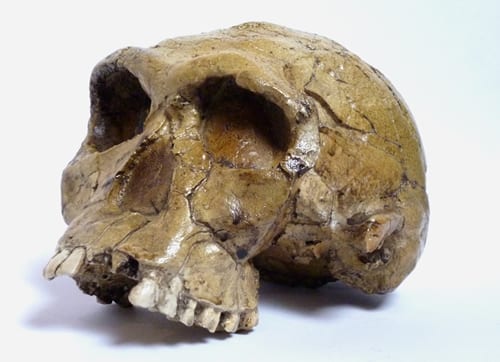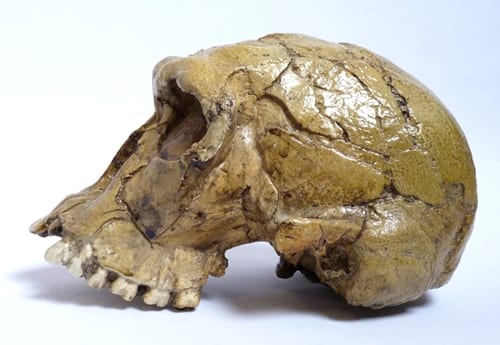Specimen of the Week 260: the handy man
By Will J Richard, on 7 October 2016
Hello internet! Will Richard here, picking another favourite from the Grant Museum’s shelves. And this time I’ve chosen a close relative and probably the first ape to move beyond punching with rocks. It’s the…
**Homo habilis skull model**
The handy man can
Homo habilis, which literally translates as “handy man”, is the oldest known member of the human genus. Living between 2.8 and 1.5 million years ago, they were omnivorous, social and inhabited large areas of Sub-Saharan Africa. When first discovered in the 1960’s they were differentiated from other early hominids by a number of very human characteristics. These included bigger brains, arched feet, smaller teeth, and hand bones that suggested they could handle objects with precision. Hence handy man.
The name’s 1813, KNM-ER1813
There are currently only seven known handy man fossils. Ours is a reproduction of the catchily named KNM-ER1813 which was found in 1973 in the Koobi Fora region of Kenya and dates from approximately 1.9 million years ago. It’s an almost complete cranium but is considerably smaller than other comparable examples. The molars are “fully erupted” and significantly worn so this cannot be the skull of a child and is most likely a small, adult female. She would probably have stood about three and half feet tall.
Space and time
H. habilis is widely believed to have been a prolific tool maker, using flint hand axes to butcher meat and cut up animal skins. They were originally thought to be the first apes to do so, but recent evidence places the earliest tools before the earliest H. habilis fossils. It is actually impossible to say definitively whether or not handy man used tools at all, as multiple species of early hominids co-existed in the same place at the same time. This cross-over also calls into question the idea of a linear evolutionary progression with later species moving sequentially closer to modern humans. Recent finds have shown that H. habilis and H. erectus lived together in East Africa for approximately 500,000 years, for example, whereas earlier thinking was that H. erectus was a direct descendant of handy man with little or no overlap.

Homo habilis reconstruction. Author unknown; CC-BY-SA-3.0 via Wikimedia Commons
Family matters
It is difficult to know how closely related we really are to H. habilis and it is a debate which has split experts since the species’ discovery. Some scientists still see its identification in the human genus, Homo, as a mistake. They maintain that handy man has far more in common with the more ape-like species of Australopithecus than it does with later hominids and so belongs there. Others argue that the gulf is wide enough. It is, however, unarguable that H. habilis does represent a significant step towards those later hominids, though I’m sure that the differences over the details will continue until the evidence is overwhelming. And seven partial fossils is a long way from overwhelming…
References
http://humanorigins.si.edu/evidence/human-fossils/species/homo-habilis
http://humanorigins.si.edu/evidence/human-fossils/fossils/knm-er-1813
Leakey, L.S.B., Tobias, P.V., Napier, J.R., 1964. A new species of the genus Homo from Olduvai Gorge. Nature 202, 7-9.
Domínguez-Rodrigo, M., Pickering, T.R., Semaw, S., Rogers, M.J., 2005. Cutmarked bones from Pliocene archaeological sites at Gona, Afar, Ethiopia: Implications for the functions of the world’s oldest stone tools. Journal of Human Evolution 48, 109-121.
Will Richard is Visitor Services Assistant at the Grant Museum of Zoology
 Close
Close



